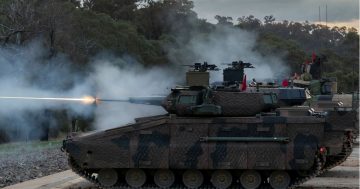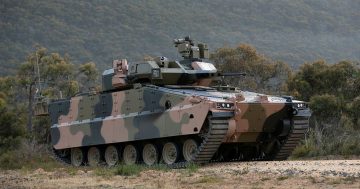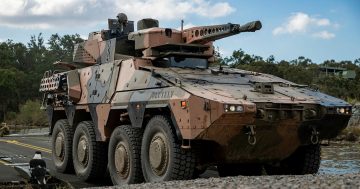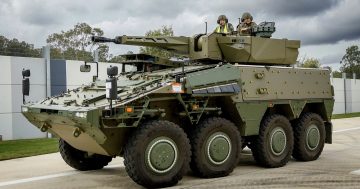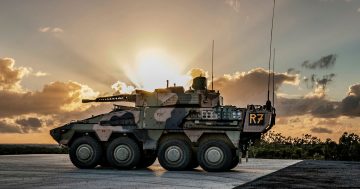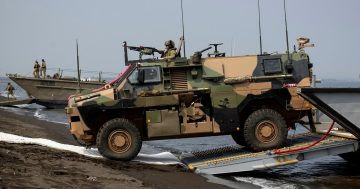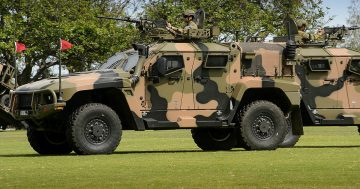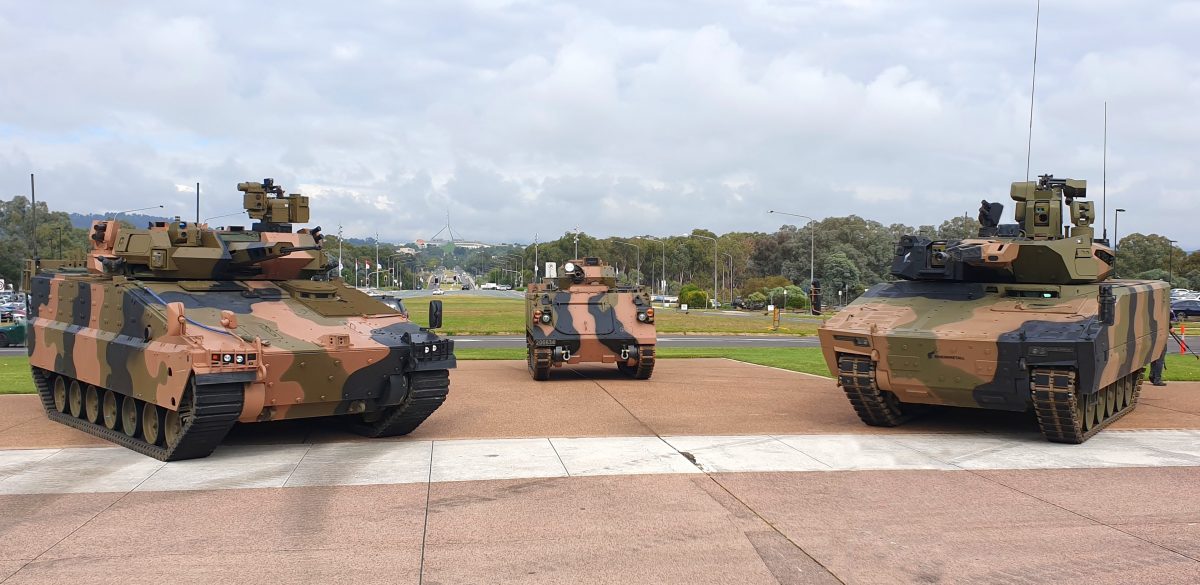
The Hanwha Redback (left) and Rheinmetall Lynx (right) dwarf the Vietnam-era M113AS4 vehicle one of them will replace, during a 2021 open day at Canberra’s Blamey Square. Photo: Andrew McLaughlin.
A major project to replace a fleet of Vietnam-era armoured personnel carriers (APC) for the Australian Army is under review, as the overall requirement for the vehicles is called into question.
When issued in 2021, the Project LAND 400 Phase 3 Mounted Close Combat Capability requirement called for 450 new heavy Infantry Fighting Vehicles (IFV) to each carry up to a dozen troops.
In October 2021, after two years of comprehensive risk-mitigation testing, two companies submitted their final bids for the up to $27 billion tender– Hanwha Defence Australia, and Rheinmetall Defence Australia.
With each weighing about 42 tonnes, the 6.9m-long Hanwha AS21 Redback and the 7.4m-long Rheinmetall KF41 Lynx IFVs are considerably larger and more sophisticated than the 6m-long, 18t M113AS4 APCs they will replace. Both are armed with 40mm cannons, anti-tank missiles, and machine guns, feature advanced communications and sensors, and have armour and countermeasures capable of defeating most anti-armour weapons.
It should be noted that IFVs are not ‘tanks’. Main Battle Tanks (MBT) such as Australia’s M1A1 Abrams weigh about 70 tonnes, have a crew of three or four, and are built around large-calibre guns designed specifically for destroying enemy tanks and vehicles or fortified structures.
MBTs are vital tools for land or joint force campaigns where the goal is to take and hold ground, and are usually operated in conjunction with infantry who are either mounted in IFVs or dismounted on foot.
The requirement for much higher levels of protection for IFVs came from the wars in Afghanistan and Iraq in the past two decades where, early in those conflicts, armoured vehicles were defeated or destroyed by crude roadside improvised explosive devices (IEDs) or Soviet-era shoulder-fired anti-tank weapons. This led to the development of heavier armour, angled panels and decks, and V-shaped blast-resistant hulls meant added protection for crews and embarked troops, which in turn led to a dramatic increase in vehicle weight.
Despite those wars now being behind us, the threat of advanced anti-armour weapons is only increasing. As we have seen in recent conflicts in Nagorno-Karabakh, Syria, and Ukraine, older armoured vehicles are particularly susceptible to advanced shoulder-launched guided missiles like the FGM-148 Javelin supplied to Ukraine by the US, as well as the increased proliferation of drone-launched weapons.
So, while providing increased protection against these threats, this has led to two new issues, especially for potential operators as small as the Australian Army. The first is cost – up to $27 billion for 450 armoured vehicles is a lot of money, although the project also includes new base facilities, training systems, weapons and ordnance, options for more vehicles, and an initial sustainment package.
Regardless of who wins the bid the IFVs will be manufactured in Australia, so at least a proportion of that money spent will stay in the country.
Both companies are also offering substantial wider global supply chain opportunities for Australian industry should they be selected.
The second issue is, how does a defence force as small as Australia’s transport these new vehicles? If used on Australian soil, the IFVs can be deployed reasonably rapidly by dedicated road or rail transport and, when used in conjunction with Abrams tanks and air-defence systems, would be capable of mounting a viable defence of any population centre or base in Australia’s north.
But if an offshore deployment is required, only one IFV can be carried at a time in a Royal Australian Air Force C-17, the ADF’s largest transport aircraft – of which it has just eight. The Royal Australian Navy has two large landing helicopter dock (LHD) vessels capable of embarking up to 100 armoured vehicles but, unless there are appropriate port facilities at the destination, only four IFVs at any one time can be put ashore on amphibious landing craft.
Because of some of these doubts that have been raised in the media and by defence thinktanks such as the Australian Strategic Policy Institute (ASPI), it has been reported that the number of IFVs to be acquired may be cut from 450 to fewer than 300, and that the money saved may be diverted to other, more time-sensitive priorities identified in the Government’s new Defence Strategic Review, or pushed to the right to help address Australia’s huge post-pandemic economic debt.












